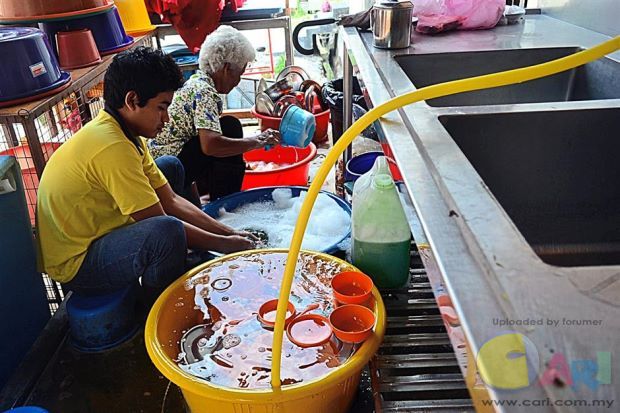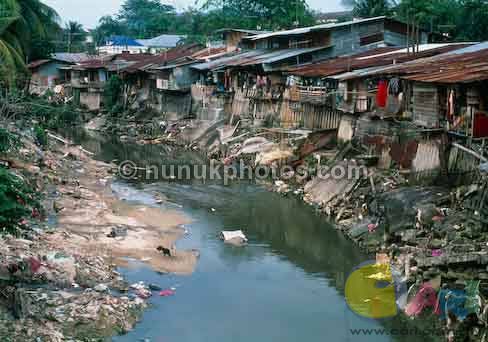Across Malaysia, rivers are our main source of tap water. So why are we still throwing our rubbish down the river? Man-made causes of river pollution still lurk as a threat to safe drinking water in Malaysia. For example, the recent dry spell has led to poor dilution of pollutants in Selangor's Sungai Langat, rendering the river unsuitable for water extraction. As ammoniacal nitrogen levels soared above permissible levels in late January – due to pollution from sewage, fertiliser runoff and sullage – two water treatment plants in Cheras and Dengkil were shut, leading to dry taps in over 20,000 households in Hulu Langat and Kuala Langat. Though there have been commendable river cleaning programmes, these are of little help in the long run if the root of the problem isn't addressed. It's common practice among housewives to dump waste down the kitchen sink or into drains. This waste is carried by the drainage system into rivers. So it’s simple science that our rivers become polluted when our drains are, says Global Environment Centre (GEC) river care programme coordinator Dr K Kalithasan.  “Drains are built to transport stormwater runoffs into the river, so what goes into the drain eventually comes out at the river, the source of our drinking water. The runoff or sullage that's fed directly into drains from offices, shoplots and restaurants contains pollutants like oil, chemical compounds and heavy metals. You also have pesticides, fertilisers, solid waste and discharges from poorly-maintained septic tanks in residential areas, which all contribute to drain pollution," says Dr Kalithasan. “If anything, pollution minimisation should be looked into first as it is very expensive to clean and maintain rivers. We have always advocated the importance of treating waste, whether liquid or solid, at the source, or it will be pointless to clean the rivers. This is why the ‘Love Our River’ campaign has generally failed to achieve its objective,” he adds. Kalithasan says most times, polluted rivers can't be rehabilitated to their original and natural condition. But he says one way of minimising drain pollution is by installing grease traps to capture oil, and to keep these traps regularly maintained. “There are people who pour oil into roadside or garden drains, which generally flow into rivers. Also, irresponsibly-constructed toilets that connect to drains, bypassing the sewage plant, means that wastewater flows directly into the river. We have to understand that most sewage treatment facilities in Malaysia are unable to treat oil and grease. In this case, we can help by segregating liquid waste, such as cooking oil, from the solids.” Even in homes where the drainage is connected to the central sewage network, anything that's indiscriminately discarded will add to the burden of treatment plants. Indah Water Konsortium (IWK) concurs on the need for grease traps to arrest the problem of organic waste from restaurants and commercial areas. However, the installation of these traps is under the purview of local authorities. “Local authorities will have to carry out enforcement to combat any improper oil and grease traps, and illegal discharge of oil and grease into the sewerage system. Besides causing blocked sewer lines, the oil and grease will eventually flow into the sewage treatment plant. Since the sewage treatment undergoes a biological process, any excessive amounts of oil and grease will be harmful to the bacteria, and disrupt the entire process. To revive the process, extensive cleaning is required to bring the bacteria back to the right environment,” says IWcommunications department senior manager, Shahrul Nizam Sulaiman,Shahrul. It’s baffling to note the kind of items that end up in sewers – condoms, sanitary pads, toys, hardened cement, earth, sand, oil and grease, including those from vehicle workshops. The Association of Water and Energy Research Malaysia president S Piarapakaran cites how “river rehabilitation” programmes focus on removing solid waste or rubbish, while wastewater discharges from industries, commercial areas and households continue to pollute the river. “The only solution to this is to divert the wastewater into a pre-treatment facility before it is discharged into the river itself,” he says. He opines that the cause of river degradation is liquid waste, given that solid waste can be easily removed. The main task lies in raising wastewater quality. “We must be made aware that 82.2% of the raw water for our water supply is directly drawn from rivers. So what we throw in is what we get back as raw water for consumption.” According to the Malaysia Water Industry Guide 2013, there are 4,380 communal septic tanks, 1,298,207 individual septic tanks, and 894,859 pour flush sewerage systems used by 11.6 million people in Peninsular Malaysia and Labuan. “These systems need to be upgraded periodically in order to achieve better wastewater discharge standard,” says Piarapakaran. He says in the Langat River basin in Selangor, more than 33,000 individual septic tanks discharge partially-treated wastewater into drains. “These are old septic tanks and we need to ensure that they are desludged once every three years in order for the tanks to function effectively. If the desludging is done periodically, the level of ammoniacal nitrogen can be reduced significantly for this river.” Piarapakaran also urges for the restructuring of IWK under the Water Services Industry Act 2006 – now into its fourth year of delay – to be sped up. This will prevent a lot of unwanted pollution since not everything falls under IWK’s jurisdiction right now. Dr Kalithasan says the panacea to this issue is to implement proper drainage management, as dictated by the Department of Irrigation and Drainage guidelines. “But this approach will be meaningless if the amount of pollutants entering drains isn't reduced, which means it has to come with public education on the importance of having clean drains in the neighbourhood,” he says. To educate people on the importance of drainage management as part of river management, he says GEC has initiated "My Drains Day" events with activities such as pollution mapping and drain clean-ups. http://www.thestar.com.my/Lifest ... our-drinking-water/
|
ADVERTISEMENT